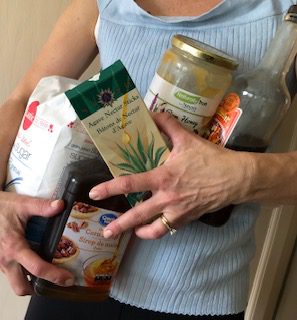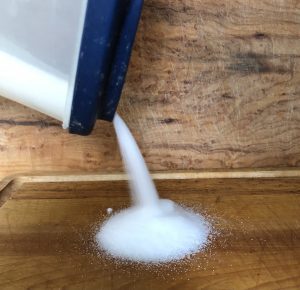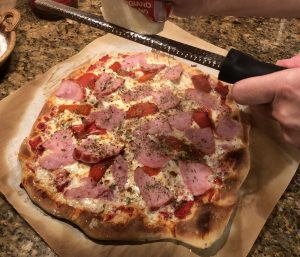You bet there is…but not without knowing the supporting science first!
Sugar is 50% glucose to 50% fructose. Glucose is the main fuel source for the body because it fuels all the muscles and organs. It’s even present in healthy fats as the glyceride part of the fat molecule – triglyceride!
Fructose, on the other hand, is NOT a fuel source for the body. Fructose is twice as sweet, changes itself into body fat, and can trigger that rush of emotions that scream “I NEED MORE!!!”
Glucose, when consumed alone, raises blood sugar very quickly. That’s its job and that’s why its Glycemic Index (GI) is near the top of the range. Glucose’s GI is 100! Conversely, sugar and fructose do not raise blood sugar as quickly and have GI’s of 65 and 20, respectively! To clarify, a high GI means an abundance of fuel (glucose) readily available for the body.
So how do pure corn syrup (GI 90), maple syrup (GI 54), honey (GI 50), and agave (GI 15) measure up? Well, the lower the GI, the higher the fructose. Your tongue knows the difference. Corn syrup is less sweet than sugar (GI 65) while maple syrup, honey, and agave get sweeter, respectively. Keep in mind, the sweeter the sweet, the less you will need, but…
Here’s comes the twist…the glycemic index is only accurate when you eat these sweets in isolation! If any of these sweets are combined with fat, protein, or fibre, the GI plummets due to the slowing effect that those three nutrient’s have on the body’s ability to get the glucose into the blood stream.
This is the scientific basis behind the Balance Factor where combining fat, fibre, and protein with carbohydrates (ie. sweeteners) lowers the carbohydrate’s GI. This is why a peanut butter cookie’s GI where its recipe uses corn syrup (GI 90) and peanut butter (GI 14) will be somewhere between 90 and 14. The cookie’s GI plays tug of war depending on how much of the ingredient you use – the more corn syrup, the closer the GI will be to 90; the more peanut butter, the closer the GI will be to 14.
Which brings us to the question of which sweetener to use? This depends on three things…1) the amount the recipe calls for, 2) what you are trying to sweeten, and 3) the flavour you are looking for.
If your recipe blends a lot of ingredients that together produce a unique flavour like cinnamon buns, then use high GI sweeteners in a 2:1 ratio of sugar to corn syrup. (1 cup sugar = 2/3 cup sugar + 1/3 cup corn syrup) The glucose will be delayed by the other ingredients and will enter the blood stream as a controlled energy source. (You might need to add 2 Tbsp flour to offset the water in the corn syrup.)
If you are looking to sweeten foods like your coffee but not change the flavour, use pure corn syrup or dextrose (powdered glucose). Both will fuel your body, both will prevent an addiction reaction and both are available in the grocery store.
If you are looking to add a certain flavour to just a few, simple, raw ingredients like salad dressings, use the lower GI sweeteners. Those will provide the flavour and sweetness you are looking for but only add a small amount of unnecessary fructose to your diet.
There is no arguing that the body requires glucose; it just doesn’t need mass amounts all at once. Glucose or Maltose (GI 105) from whole grain carbohydrates like bread, pasta, quinoa, or rice, is best when combined with other non-carbohydrate whole foods. On the other hand, all-sugar foods like gummy bears and soda might warrant a surgeon general’s warning on the label saying “Eating high GI foods in isolation can lead to high blood sugar, obesity, heart disease, and type 2 diabetes”.
To learn the GI’s of all your favourite sweeteners, check out http://www.sugar-and-sweetener-guide.com/glycemic-index-for-sweeteners.html




